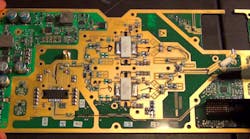Amplifiers Boost Test Signals to 26.5 GHz
If I only had a few more watts of power! That exclamation has no doubt haunted more than a few high-frequency engineers in RF/microwave laboratories for some time, as it’s typically followed by a search for an amplifier capable of boosting low signals to levels suitable for analysis.
In many cases, such an amplifier may be part of the MPA Series of test-and-measurement instrument amplifiers from Maury Microwave. The test amplifier line covers some of the more popular high-frequency bands from 700 MHz to 26.5 GHz with high gain and as much 50 W saturated output power. The amplifiers can drive signals of interest to levels suitable for testing with measurement equipment such as a spectrum analyzer, scalar network analyzer (SNA), or a vector network analyzer (VNA).
The durable instrumentation amplifiers leverage the capabilities of gallium-nitride (GaN) power-amplifier (PA) modules to cover wide swaths of the total frequency range of 0.7 to 26.5 GHz, including 0.7 to 6 GHz; 2 to 6 GHz; 2 to 18 GHz; 6 to 18 GHz (see figure); 8 to 12 GHz; and 18 to 26.5 GHz. Available output power typically decreases with increasing frequency. As much as 50 W saturated test signal power is available through 6 GHz, with up to 30 W test signal output power from 2 through 18 GHz, and as much as 5 W test-signal power from 18.0 through 26.5 GHz.
The MPA line of instrumentation amplifiers consists of rugged rack-mount units based on GaN power transistors, all of which are capable of 50 W saturated output power at microwave frequencies, such as this 6- to 18-GHz unit.
The amplifiers include built-in protection circuitry that monitors key functions, such as fan status, temperature, and amplifier module current draw. An amplifier will power down to prevent damage when faults are triggered to prevent damage.
The frequency breakdowns of the instrument amplifiers enable specifiers to focus on one or more frequency bands of interest. This helps to achieve test-signal power levels at microwave frequencies capable of applying real input-power stress to a device under test (DUT) at microwave frequencies.
For example, model MPA-0G7-6G-50 is able to produce at least 50 W saturated output power from 0.7 to 6.0 GHz. It can handle input signal levels as high as +3 dBm without overload, and delivers at least 49-dB small-signal gain with ±4 dB gain flatness. It also has a manual 20-dB gain adjustment range for varying the amount of gain provided to a DUT.
The MPA-0G7-6G-50, like the other members of the MPA instrument amplifier line, is constructed for high reliability, in a durable, rack-mount enclosure with generous heat fins and forced-air cooling to prevent heat buildup around the GaN active devices. It’s designed to function with worst-case input VSWR of 2.50:1, while holding second-harmonic levels to typically −15 dBc and spurious levels to typically −65 dBc across the frequency range. It withstands load VSWRs as high as 3.0:1 while running at its rated saturated output-power level.
For those not needing as much test power, the MPA-0G7-6G-16 instrument amplifier provides at least 16 W saturated output power over the same 0.7- to 6.0-GHz frequency range. It has somewhat less (44-dB) small-signal gain and the same 20-dB gain-control range.
At the upper part of the frequency coverage, model MPA-18G-26G5-5 achieves at least 5 W saturated output power from 18.0 to 26.5 GHz. The instrument amplifier features typical 37-dB small signal gain, with typical gain flatness of ±4 dB and a 15-dB gain control range.
When less output power is needed over this upper-microwave-frequency range, the model MPA-18G-26G5-1 instrument amplifier provides 1 W output power with 30-dB small-signal gain and 15-dB gain control range. Given the high test frequencies of the second harmonics, those levels are not specified for these two 26.5-GHz amplifier models, but they’re both rated for almost-negligible spurious levels of −65 dBc.
For frequencies in between, such as the brunt of electronic-warfare (EW) testing, the model MPA-2G-18G-30 delivers at least 24 W and typically 30 W saturated output power from 2 to 18 GHz. It can handle input-power levels to +5 dBm and apply 39-dB small-signal gain with typical gain flatness of ±4 dB across that wide frequency range. Second-harmonic levels are typically −15 dBc and spurious levels are typically −65 dBc at maximum saturated output power.
If not quite so much output power is needed over the same wide frequency range, the model MPA-2G-18G-16 instrument amplifier provides at least 13 W and typically 16 W saturated output power with 41-dB small-signal gain and ±4-dB gain flatness. Both 2- to 18-GHz instrument amplifiers provide 20-dB gain-control ranges.
These represent a few examples of the standard instrument amplifier models. All are designed for operating temperatures from 0 to +50ºC. For special test needs, semi-custom versions can be created to meet requirements that may be non-standard in terms of output power, frequency range, or other performance parameter. All custom amplifier requests are evaluated on a case-by-case basis, and the capabilities of the amplifier design team are matched against the requirements of the custom request.
Coming from a company long associated for its load-pull measurement tools and test systems, the amplifiers are rigorously burned-in and tested prior to shipment to ensure that they will meet a customer’s reliability expectations. Whether for production or R&D, test equipment is usually the hardest-working gear in a company, and these amplifiers are thoroughly tested for high reliability, even when subjected to non-stop use. Each amplifier is tested prior to shipment. The complete test report is included with the amplifier, along with a two-year warranty and the backing of the company throughout the expected long lifetime of the amplifier.
Maury Microwave Corp., 2900 Inland Empire Blvd., Ontario, CA 91764; (909) 987-4715.


